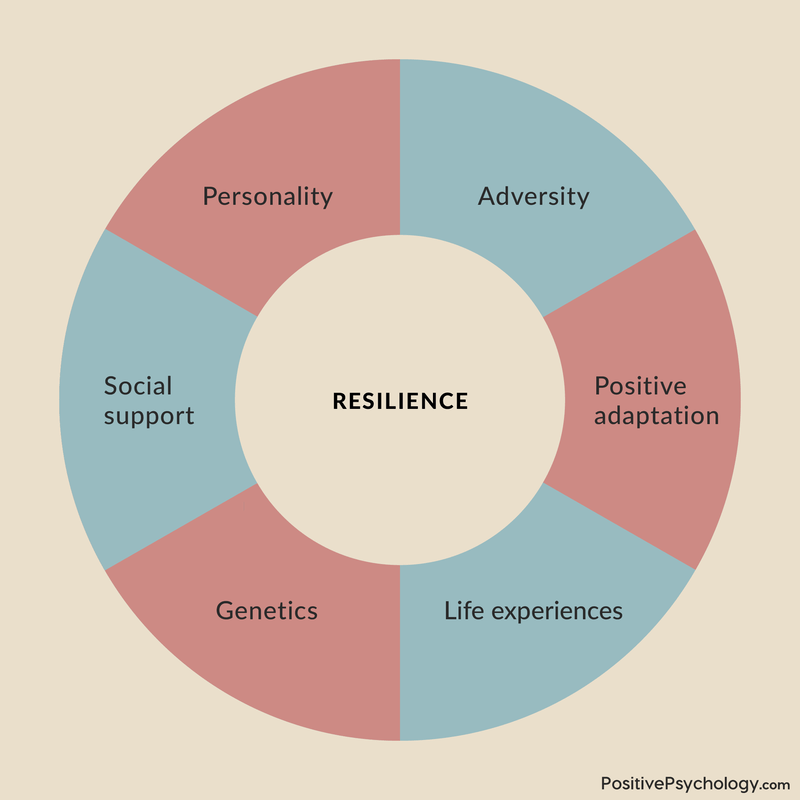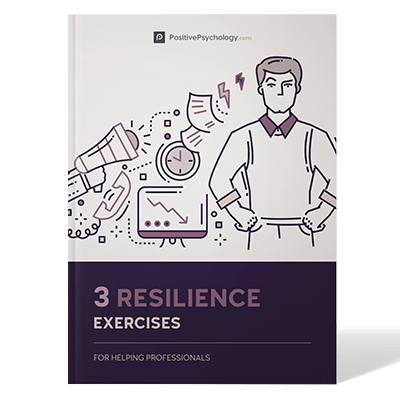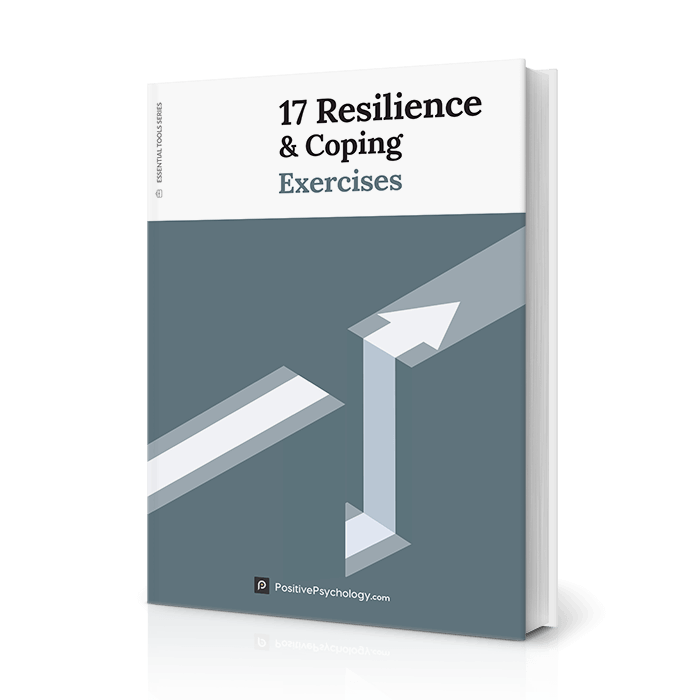What Is Resilience, and Why Is It Important to Bounce Back?

Why does one person embrace the tough times while another crumbles?
Research recognizes that many factors come into play regarding how resilient we are, including our traits, environmental factors, and a learned capacity associated with experience (Pemberton, 2015).
While our ability to bounce back from the obstacles that life throws at us is, without a doubt, an essential aspect of resilience, it can also surface in other equally adaptive ways that challenge our understanding of the concept (Neenan, 2018).
In this article, we not only answer what resilience is, but dig deeper into this complex yet essential concept and explore how resilience theory can improve our understanding and inform our practices with clients.
Before you continue, we thought you might like to download our three Resilience Exercises for free. These engaging, science-based exercises will help you effectively deal with difficult circumstances and give you the tools to improve the resilience of your clients, students, or employees.
This Article Contains:
What Is Resilience, and Why Is It Important?
People can survive the most challenging ordeals—some even thrive. And yet, they may be unaware or unclear exactly how they got through the challenges they faced (Neenan, 2018).
Inner resilience is an important resource that appears to be the secret to success in the outer world and the basis of good mental health (Neenan, 2018).
The suggestion that resilience is simply being able to bounce back most likely comes from its use in the physical sciences. A resilient material can return to its original state after being bent or stretched—often dramatically. Just think of a bridge spanning a wide river, maintaining its integrity despite twisting in the wind, or a small flower growing through concrete (Pemberton, 2015).
Similarly, resilience in the human context has been described as the “capacity to remain flexible in our thoughts, feelings, and behaviors when faced by life disruption, or extended periods of pressure, so that we emerge from difficulty stronger, wiser, and more able” (Pemberton, 2015, p. 2).
Being Resilient: Its Meaning in Psychology

Following a significant event, such as the death of a loved one or an unexpectedly bad medical diagnosis, even the most resilient person is unlikely to return to the path they were on—or at least remain unchanged.
Instead, psychology recognizes that resilient individuals going through significant life events do not always recover effortlessly; they often find a new path. Even when knocked by what has happened, the darkest times still typically lead to growth, including (Neenan, 2018):
- A new or revised self-image
Resilient people become aware of unexpected abilities as they rise to each new challenge. - Enriched and clarified relationships
During difficult times, they recognize the friends who remain and offer support and those who no longer return calls or are toxic or draining and prioritize positive relationships. - Altered priorities
A new and possibly more focused perspective can remove what is unimportant and clarify and motivate meaningful values, life goals, and priorities.
A renewed purpose can also strengthen the resolve of those who are already resilient. “Studies have found that having a clear and valued purpose, and committing fully to a mission, can markedly strengthen one’s resilience” (Southwick & Charney, 2018, p. 251).
What is psychological resilience?
Over time, stress can have a damaging impact on our psychological, emotional, and physical wellbeing. Psychological resilience can protect individuals from its effects and boost their ability to regain a sense of control in their lives (Southwick & Charney, 2018).
While there are many definitions of resilience, psychologists typically agree that it is a multi-fold concept, made up of both the capacity to handle difficult times and our ability to respond flexibly. Some researchers go further, identifying the following three factors as essential to resilience (Boniwell & Tunariu, 2019):
- Recovery
Returning to normality or the pre-stressor degree of functioning - Resistance
Limited or no signs of disturbance following the stressor - Reconfiguration
Returning to a different homeostasis and finding new stability according to the change in circumstances
Unlike recovery or resistance, reconfiguration is an essential part of the process of transformation the individual experiences when a return to their original path is difficult or unthinkable (Boniwell & Tunariu, 2019).
The three secrets of resilient people – Lucy Hone
6 Signs of Resilience in Life
Resilience research recognizes each of the following as both facilitators and indicators of resilience in individuals (Boniwell & Tunariu, 2019; Neenan, 2018):
- Reframing
Looking at a problem or situation from a different, more helpful perspective can help the individual cope. - Using the power of positive emotions
Such feelings broaden our thinking and enable us to come up with alternative strategies for solving problems more creatively. They can also improve our sense of belonging, helping us bond with supportive individuals and groups and boosting our sense of accomplishment and ideas of purposeful living. - Participating in physical activities
Being more active can help manage and reduce the impact of stress along with improving confidence and self-esteem. - Ongoing active engagement in trusted social networks
Social support from trusted friends, colleagues, and family members can leave us feeling less isolated and help us adopt a better perspective regarding what is happening. - Identifying and using signature strengths
Engaging our strengths can leave us feeling more authentic, increasing our sense of meaning and control when we take on new challenges or overcome adversity. - Optimism regarding the future
Looking toward the future with optimism can help us recognize that setbacks are usually temporary and surmountable, helping us feel more hopeful and positive about what lies ahead.
The above are all valuable signs to watch out for with clients to assess their readiness and ability to adopt a more resilient outlook on life.
What Are the 10 Resilience Skills?

Instead, it is the development of a resilient mindset, a set of tools and skills to manage challenging times, and the creation of a supportive and growth-minded environment (Boniwell & Tunariu, 2019; Neenan, 2018).
The following 10 resilience skills can be shared and developed with clients to help them become more resilient (Duckworth, 2016; Pemberton, 2015; Southwick & Charney, 2018):
- Problem-solving
Problem-solving is the ability to identify, analyze, and break down problems and generate potential solutions. The most effective ones are then chosen and implemented. - Goal setting
Goal setting involves setting well-defined and achievable goals and then taking small steps toward achieving them. Working toward goals builds confidence and a sense of accomplishment, which can contribute to resilience. - Effective communication
This involves learning to express needs and feelings clearly and assertively and actively listening to others. - Emotional regulation and stress management
Since emotional regulation is the ability to control and manage one’s emotions in a healthy way (Gross, 1998), specific approaches can manage emotions and stress.
These include practicing relaxation techniques (including mindfulness and deep breathing), cognitively reframing challenges and pressures as opportunities, and engaging in physical activity. - Building a social support network
This involves developing and maintaining a solid network of supportive relationships with friends, family, and other trusted individuals. - Practicing self-care
Self-care activities should promote physical, emotional, and mental wellbeing, including getting adequate sleep, eating a healthy diet, exercising regularly, and finding time for relaxation and hobbies. - Developing meaning and purpose in life
This involves finding purpose and meaning in life, whether in work, relationships, or other personally fulfilling activities. - Adopting a positive outlook
Cultivating a positive outlook and a growth mindset might include practicing gratitude, focusing on the good things in life, reframing negative thoughts, and seeing setbacks as opportunities for learning and growth, while maintaining a hopeful outlook. - Improving self-awareness
Developing self-awareness includes learning to understand thoughts, emotions, and behaviors to improve responses to stress and adversity and recognizing when to seek support. - Adopting effective coping strategies
Healthy coping mechanisms might include positive self-talk, visualization, exercise, goal focus, social support, mindfulness, and relaxation techniques.
Resilient individuals are typically more adaptable, open to new changes and experiences, and adopt a healthy perspective when they see setbacks as opportunities for learning (Neenan, 2018).
Over the last few decades, comprehensive research into resilience has found several protective and promotive factors that make some individuals more resilient. They include self-regulation skills, effective schooling, good parenting, genetics, mindset, and community resources (Lopez et al., 2021).
The most resilient people are likely to have benefited from a combination of these basic human protective systems.
It is worth noting that resilience is not a fixed trait, but can be developed and grown over time. Let’s look at how to improve resilience. Resilience is a sought-after trait we can all benefit from, but what does resilience really mean? How do we show resilience, and how do we recognize resilience in others? The two key components of resilience are adversity and positive adaptation. Resilience is often referred to as the ability to ‘bounce back’ in the face of adversity. Without adversity, we are not challenged, and therefore not required to adapt. Critically, the ‘bounce back’ is positive, often leading to the establishment or reinforcement of our inner strengths. The cognitive and emotional tools we develop when we adapt to adversity equip us to deal with what we may face in the future. A wide range of factors influence resilience. There is debate over the extent of the impact of each factor, although it is largely agreed that genetics, personality, social support, and life experience all play a role (Fletcher & Sarkar, 2013). Thinking about these core concepts allows us to reflect on situations where we have had the opportunity to develop resilience and identify times when we have been more or less resilient. Understanding why some people tend to bounce back more effectively than others in the face of adversity is critical for supporting those going through challenging times.

How to Build Resilience

While there are many, we can group several of these approaches as follows (Boniwell & Tunariu, 2019; Shapiro, 2020).
Positive psychology interventions
Active interventions
Exercise, particularly high-intensity exercise, positively affects psychological and physical wellness and reduces the impact of stress.
Similarly, reducing unhealthy behaviors, such as smoking or drinking too much alcohol, is equally beneficial. Exercise can provide a foundation for coping with stress and adversity. As a means to manage stress, it improves your ability to be resilient.
Calming interventions
Mindfulness, deep breathing, and relaxed activities, such as mindful walking or mindful yoga, are particularly effective at managing existing and future life challenges.
Acceptance and Commitment Therapy combines techniques to teach clients how to accept difficult thoughts, feelings, and sensations without reacting in unhelpful or unhealthy ways.
Identity interventions
Recognizing our core selves through understanding and using our signature strengths more frequently helps us perform at our best, feel energized, and experience control during difficult times.
Online tests such as the Values in Action test or the Clifton Strengths survey can help us become more resilient and flourish in our personal and working lives.
Optimizing interventions
Finding ways to realize who we want to be can help us live more fulfilling, meaningful lives in line with our core values, protecting us from stress and maintaining a more resilient outlook.
Focusing on hope and optimism and setting and working toward goals to build psychological capital are powerful approaches.
Overcome a lack of confidence
Confidence, commitment to the task, feeling in control, and being up for a challenge form the four Cs of mental toughness—a term closely aligned with resilience. Researchers define mental toughness as feeling self-assured in our abilities and dealings with others (Clough et al., 2021).
Those lacking in confidence typically perform less well and have negative perceptions of self-worth (Clough et al., 2021).
We can grow confidence by focusing on past successes and recognizing our strengths. At the same time, positive role models and supporting environments are essential to nourish self-belief.
Overcome low & negative self-esteem
Self-esteem closely aligns with resilience and, as such, is greatly influenced by the mindset we adopt.
According to Carol Dweck (2017) and her research into growth mindsets, a fixed mindset can lead to poor self-esteem. If we think we are only of value when we are successful, then we are at risk of harshly judging ourselves when things go wrong.
Dweck (2017) asserts that we should recognize that none of our skills or abilities are fixed or limited. We can grow, learn, and unlearn through hard work and determination and can change how we see ourselves and the opportunities around us.
What Is an Example of Resilience?
“Ultimately, resilience is about understanding the difference between fate and freedom and learning to take responsibility for one’s own life” (Southwick & Charney, 2018, p. 290).
When journalist Bob Woodruff experienced a traumatic brain injury following a roadside bomb while filming in Iraq, it was life changing. As he couldn’t simply bounce back and restart his life where he left off, he had to create a new path for himself (Southwick & Charney, 2018).
His resilience led to the creation of the Bob Woodruff Foundation to help others recovering from combat-related injuries. He used his traumatic experience as a platform to educate and support others and, following an extended period of recovery, even returned to TV (Southwick & Charney, 2018).
Related PositivePsychology.com Resources
We have many resources available for therapists wishing to support clients as they develop their resilience.
Resilience articles
While we have various articles about resilience, we’d like to focus your attention on these three key areas.
Resilience theory
A wealth of resilience research is summarized in our article Resilience Theory. Researchers recognize that it is not the nature of adversity but how we deal with it that defines our resilience.
Developmental psychologist Norman Garmezy’s seminal work on resilience recognizes the importance of motivation, cognitive skills, personal “voice,” and social change for protecting our mental wellbeing (Masten & Tellegen, 2012).
Resilience training
Resilience is often defined by our ability to remain flexible. Rather than avoiding or fighting against stressful situations, we can be trained in resilience to reframe the adversities we face so that we adapt, progress, and move forward (Boniwell & Tunariu, 2019).
Resilience for kids
It is possible to teach resilience to school kids too—at any age. We can offer our children a head start by giving them tools to overcome challenges and better manage the inevitable stresses of life. However, we may have to back up and refrain from “over-parenting” (Rosin, 2014).
Resilience interventions
We have many resources available for therapists wishing to use positive psychology and resilience interventions to help clients build resilience skills.
Why not download our free resilience exercises pack and try out the powerful tools contained within? Some of them include:
- The Resilience Plan (The Four Ss)
This tool helps your client unpack their resilience resources by giving them a framework to bring out what works for them. - Using Values to Build Resilience
Learn how to use values affirmations to build resilience and manage and overcome stressful events.
Other free resources include:
- Resilience and Change
A set of questions to uncover your clients’ skills, supports, strategies, and sagacity to understand their psychological capital for resilience. - When Was I (Not) Resilient?
Review situations where your client coped well (and poorly) to help them identify those qualities of resilience that are more developed than others.
If you’re looking for more science-based ways to help others overcome adversity, check out this collection of 17 validated resilience and coping exercises. Use them to help others recover from personal challenges and turn setbacks into opportunities for growth.
A Take-Home Message
Resilience is the capacity to remain flexible and adaptable while facing life’s challenges. It is a complex concept involving traits, environmental factors, and a learned capacity that comes from experience.
In the context of psychology, resilience can be understood as the combined abilities to recover from, resist, or reconfigure following stress or adversity. It is a vital resource that can protect individuals from the harmful effects of stress and help them regain a sense of control in their lives, even leading to growth and positive change.
Resilience can be developed and maintained through various techniques, including seeking support, setting goals, learning from experiences, discovering and using strengths, developing coping strategies, and promoting a positive outlook.
Most clients will benefit from working with a therapist or coach to improve their resilience directly because of an increased engagement with their lives or indirectly with a newfound confidence to be open to new opportunities and possibilities.
Overall, resilience is important because it helps people, communities, and systems to thrive in the face of adversity, to manage stress and uncertainty, and to continue to develop and improve over time.
We hope you enjoyed reading this article. Don’t forget to download our three Resilience Exercises for free.
- Boniwell, I., & Tunariu, A. D. (2019). Positive psychology: Theory, research and applications. Open University Press.
- Clough, P., Strycharczyk, D., & Perry, J. L. (2021). Developing mental toughness: Strategies to improve performance, resilience and well-being in individuals and organizations. Kogan Page.
- Duckworth, A. (2016). Grit: The power of passion and perseverance. Scribner.
- Dweck, C. S. (2017). Mindset. Robinson.
- Fletcher, D., & Sarkar, M. (2013). A grounded theory of psychological resilience in Olympic champions. Psychology of Sport and Exercise, 14(4), 549-562.
- Gross, J. J. (1998). The emerging field of emotion regulation: An integrative review. Review of General Psychology, 2(3), 271–299.
- Lopez, S. J., Edwards, L. M., & Marques, S. C. (2021). The Oxford handbook of positive psychology. Oxford University Press.
- Masten, A. S., & Tellegen, A. (2012). Resilience in developmental psychopathology: Contributions of the Project Competence Longitudinal study. Development and Psychopathology, 24(2), 345–361.
- Neenan, M. (2018). Developing resilience: A cognitive-behavioural approach. Routledge.
- Pemberton, C. (2015). Resilience: A practical guide for coaches. Open University Press.
- Rosin, H. (2014). The overprotected kid. The Atlantic. Retrieved January 17, 2023, from https://www.theatlantic.com/magazine/archive/2014/04/hey-parents-leave-those-kids-alone/358631/.
- Shapiro, S. L. (2020). Rewire your mind: Discover the science + practice of mindfulness. Aster.
- Southwick, S. M., & Charney, D. S. (2018). Resilience: The science of mastering life’s greatest challenges. Cambridge University Press.
Let us know your thoughts
Read other articles by their category
- Body & Brain (49)
- Coaching & Application (57)
- Compassion (26)
- Counseling (51)
- Emotional Intelligence (24)
- Gratitude (18)
- Grief & Bereavement (21)
- Happiness & SWB (40)
- Meaning & Values (26)
- Meditation (20)
- Mindfulness (45)
- Motivation & Goals (45)
- Optimism & Mindset (34)
- Positive CBT (28)
- Positive Communication (20)
- Positive Education (47)
- Positive Emotions (32)
- Positive Leadership (18)
- Positive Parenting (4)
- Positive Psychology (33)
- Positive Workplace (37)
- Productivity (16)
- Relationships (46)
- Resilience & Coping (36)
- Self Awareness (21)
- Self Esteem (38)
- Strengths & Virtues (32)
- Stress & Burnout Prevention (34)
- Theory & Books (46)
- Therapy Exercises (37)
- Types of Therapy (64)





What our readers think
Hello, dear, I am Bani Fatemi, Ph.D. in Persian language and literature from the land of poetry and culture, Iran.I am writing an interdisciplinary article. I read the translation of your article. Your article was excellent both in terms of structure and content. I enjoyed. I congratulate you.
Hi – a friend of mine who’s a high school teacher recently told me he believes resilience is down in young people today. Have you ever heard this theory or seen any studies about this? I’m researching it now and came across your article. Very helpful. Thank you.
Hi Steven,
I’m glad you found this article helpful, and that’s an interesting perspective shared by your friend.
It’s difficult from a research perspective to say whether the resilience of young people is less than what it was in the past. One reason why is that resilience is displayed in response to adversity, and many of the forms of adversity faced by young people today are different from what they’ve been in the past (e.g., global conflict, technology, economic factors). So if young people are not as resilient as they once were, it’s hard to know whether or not this lesser ability to cope is, even in part, due to different or less well-understood stressors.
Other factors may involve changing perspectives toward parenting. For instance, there’s this notion of helicopter parenting, which is gaining increased interest in research, likely increasing in practice, and has been shown to result in decreased resilience (see Hall et al., 2021).
You’ll also note the growing awareness around psychology and mental health challenges. With this increased access to knowledge and language, more people have the words and awareness to speak up about the challenges they’re facing, so what may appear to be a reduction in resilience among young people in the aggregate may actually just be a reduction of people suffering in silence. In other words, it’s possible that about the same number of young people are struggling to demonstrate resilience to a similar degree as those in the past, it’s just that more young people in the past were doing so in silence.
I’ve only mentioned three “lenses” through which you could look at this question, but you can see it’s a complex and multifaceted issue! I.e., it’s hard to compare the young people of the past with the young people of today when the context, culture, and conditioning are so different.
Perhaps take a look at this paper by Masten (2013) for a birds-eye perspective on this question 🙂
I hope this has offered some food for thought.
– Nicole | Community Manager
i found reading this page intriguing and helpful
it is amazing how so much can go on with just one word
thanks